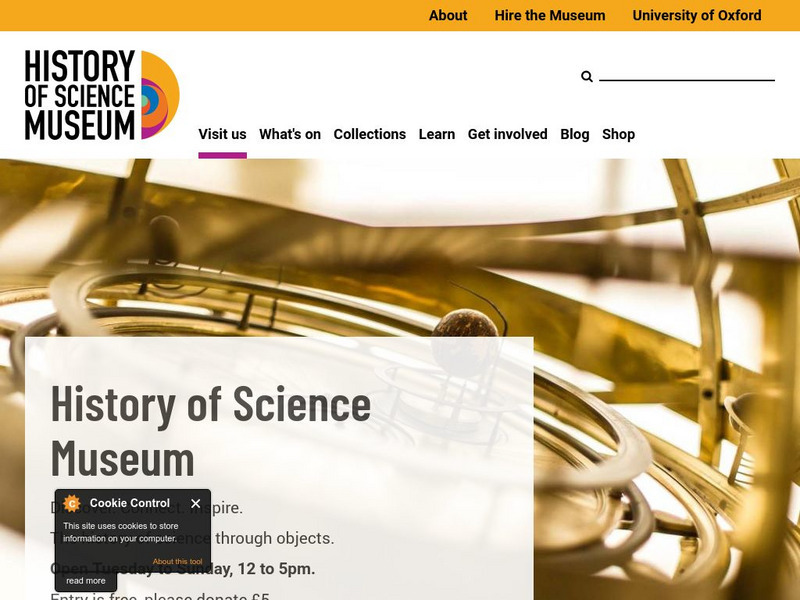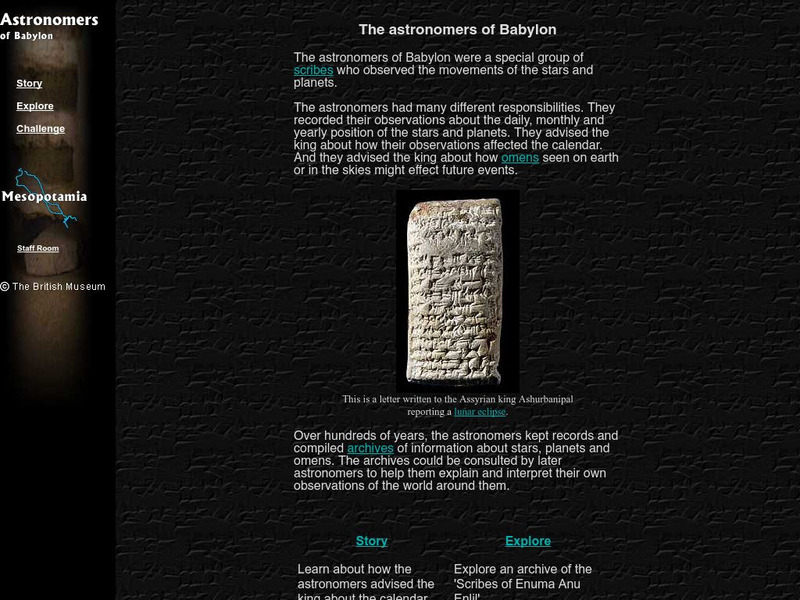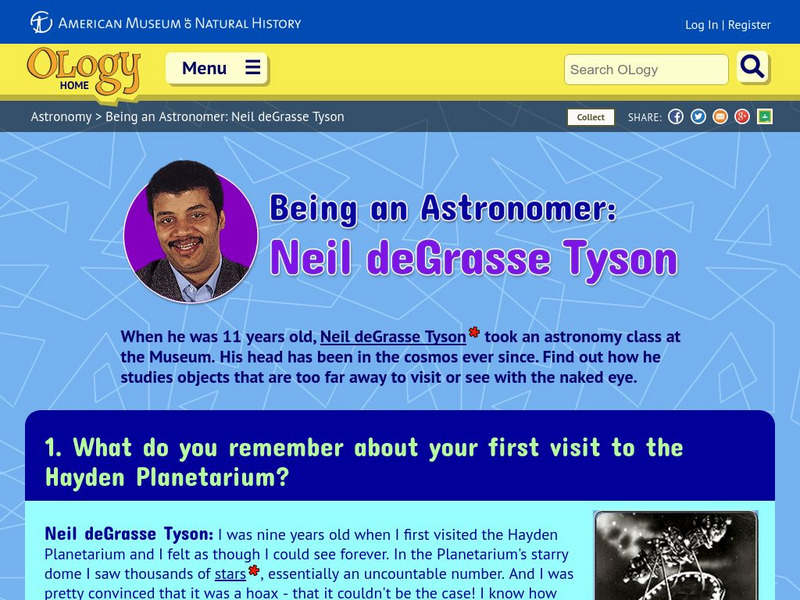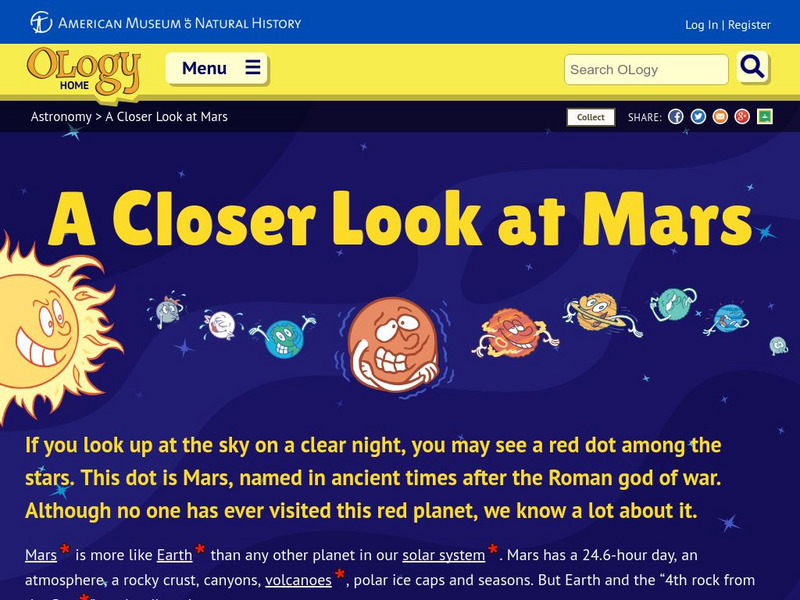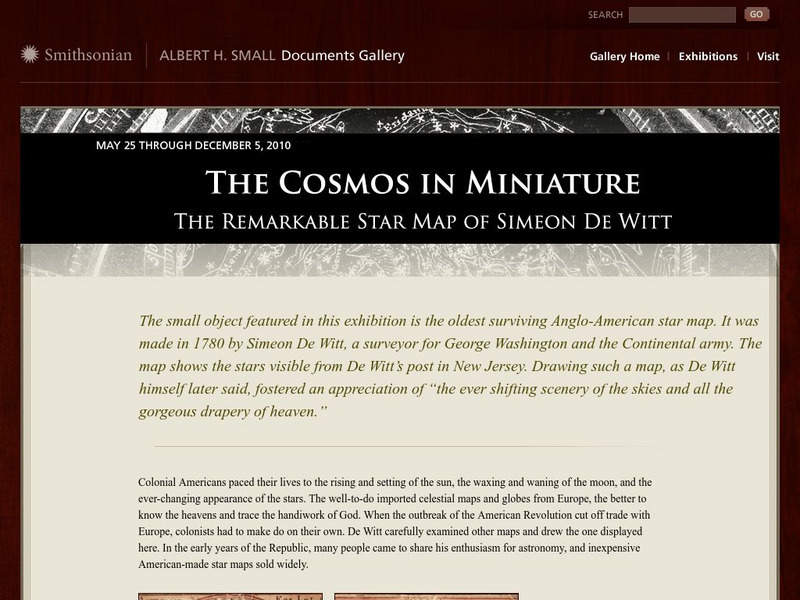American Museum of Natural History
American Museum of Natural History: O Logy: What's the Big Idea? Astronomy
An introduction to key concepts about the science of astronomy. With interactive flash cards that open in new windows to help you learn more.
American Museum of Natural History
American Museum of Natural History: Ology: Astronomy: In Pictures: Beyond Planet Earth
What would it be like to travel across the solar system and explore space? Take a look at some of the places that humans might go to someday, and the questions that scientists are asking.
Other
History of Islamic Science 3: The Time of Al Razi
In-depth look at Islamic society during the time of al-Razi. Discusses "Arabic Mathematics and Astronomy," "Muslim Alchemy and Physics," "Muslim Medicine," and several well-known individuals such as al-Mahani, inb Yusuf, al-Nairizi, ibn...
British Library
British Library: International Dunhuang Project: Chinese Astronomy Resource
Using the early Dunhuang Star Atlas, an important historical and scientific document of the sky seen from China dating from before AD 700, learn about astronomical history from the perspective of China. Find resources and analysis that...
University of St. Andrews (UK)
University of St. Andrews: Mac Tutor History of Mathematics Archive
The University of St. Andrews, Scotland, presents hundreds of biographies of famous mathematicians, histories of math in various cultures, and interesting facts on the development of important math concepts. This is a huge reference....
University of Oxford (UK)
Museum of the History of Science: Homepage
Home page for the Museum of the History of Science in Oxford. Includes on-line exhibits and an image bank.
Other
China Daily: China Culture: Astronomy and Geography
Access a collection of articles about the scientific contributions made by the ancient Chinese in the areas of astronomy and geography. Includes write-ups of famous astronomers and geographers, astronomical instruments, and more.
Other
Canadian Astronomy Education: Canadian Astronomers Making History
Get to know the Canadian astronomers who made notable contributions to modern astronomy in Canada.
Canadian Museum of History
Canadian Museum of History: Maya Civilization
Lots of information about many facets of the Maya civilization. Covers the history, people, geography, languages, cities, society, cosmology, the calendar, and lots more. Includes a glossary and a timeline.
Other
Mesopotamia: Astronomer: Astronomers of Babylon
Study the Babylonians accomplishments in astronomy. This early civilization developed a calendar and were able to predict near-future events based on the reading of the stars. Scroll through a story and engage in a challenge reinforcing...
American Museum of Natural History
American Museum of Natural History: O Logy: Meet the Astronomer: Neil Tyson
Interview with astronomer Neil de Grasse Tyson provides insights into his research interests, his career preparation, and a range of astronomy-related topics.
American Museum of Natural History
American Museum of Natural History: O Logy: A Closer Look at Mars
If you look up at the sky on a clear night, you may see a red dot among the stars. This dot is Mars, named in ancient times after the Roman god of war. Although no one has ever visited this red planet, we know a lot about it. This site...
Ducksters
Ducksters: Quiz: Renaissance Astronomy for Kids
History Questions: Renaissance Astronomy Quiz, Test, and WebQuest
Ducksters
Ducksters: Space Science: Astronomy for Kids
Kids learn about astronomy, the study of outer space including the stars, planets, comets, black holes, and the Solar System. History and astronomers in this astronomy for teachers and kids section.
American Museum of Natural History
American Museum of Natural History: Ology: In Pictures: Journey to the Stars
Two astrophysicists present images of stellar phenomena in this resource and explain why stars are so important to the existence of life on Earth.
American Museum of Natural History
American Museum of Natural History: O Logy: Stuff to Do: Stargazing
Get started on the road to becoming an expert stargazer by following these recommendations for identifying stars, planets, and constellations. Includes an example of a journal that can be used as a record of your investigations.
Smithsonian Institution
National Museum of American History: The Remarkable Star Map of Simeon De Witt
Simeon de Witt created his star map in 1780 after studying European star maps and the skies. His is the 'oldest surviving Anglo-American star map.' Read about the history of star maps, a biography of Simeon de Witt, and the influence his...
American Museum of Natural History
American Museum of Natural History: Profile: Georges Lemaitre
Find out about the life and work of the father of the Big Bang theory, Georges Lemaitre. This article describes the origin of the cosmology theory and its growing acceptance among scientists. This is an excerpt from COSMIC HORIZONS:...
Smithsonian Institution
National Air and Space Museum: Exploring the Planets: Early Discovery
This section of the exhibition gives the history of the discovery and study of space starting with the Greeks and Romans through to the early 1900's.
Ducksters
Ducksters: Astronomy for Kids: Constellations
Kids learn about the constellations in the science of astronomy. These stars that form patterns when viewed from the Earth have been studied since ancient times.
Ducksters
Ducksters: Astronomy for Kids: Space Exploration Timeline
Kids learn about the timeline of the history of space exploration including early astronomy, astronauts, spacecraft, planets, and the Moon.
Trinity College Dublin
The History of Mathematics: Roemer
A short biographical sketch of the life and work of Ole Roemer (1652-1719 CE). Identifies his scientific discoveries and contributions in astronomy.
NASA
Nasa: History of Venus Transit
NASA site recounts the history of the Venus Transits that have occurred over the past centuries and the various descriptions astronomers have written about them.
Cornell University
Cornell University: Astronomy: Aristarchus
This site from Cornell University provides a discussion of how Aristarchus arrived at his conclusions of the distance from the Earth to the Sun and Moon. Also has his methods for determining the size of the Moon and the Sun.
Other popular searches
- Ancient Astronomy
- Astronomy History
- Astronomy History People
- The History of Astronomy
- Aztec Astronomy History
- Ancient Astronomy Info
- Ancient Greek Astronomy
- Korean History Astronomy






